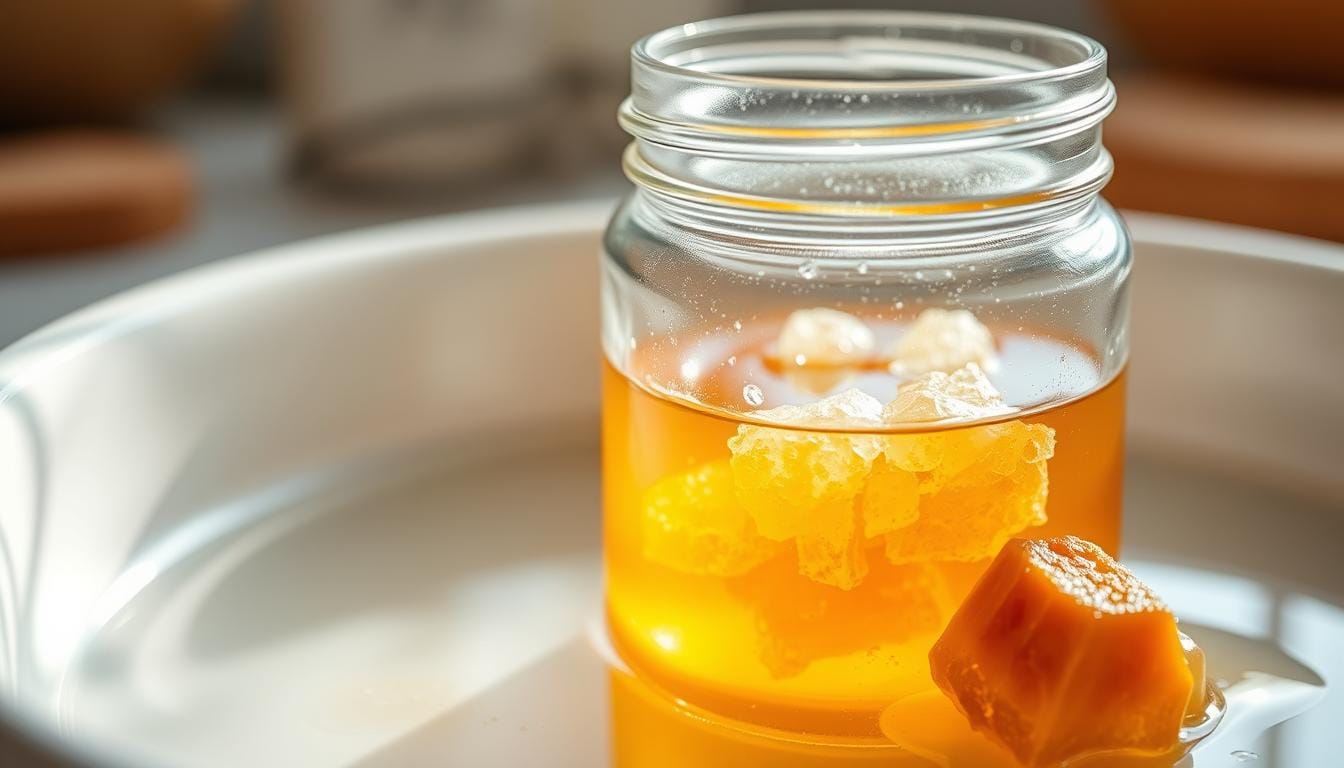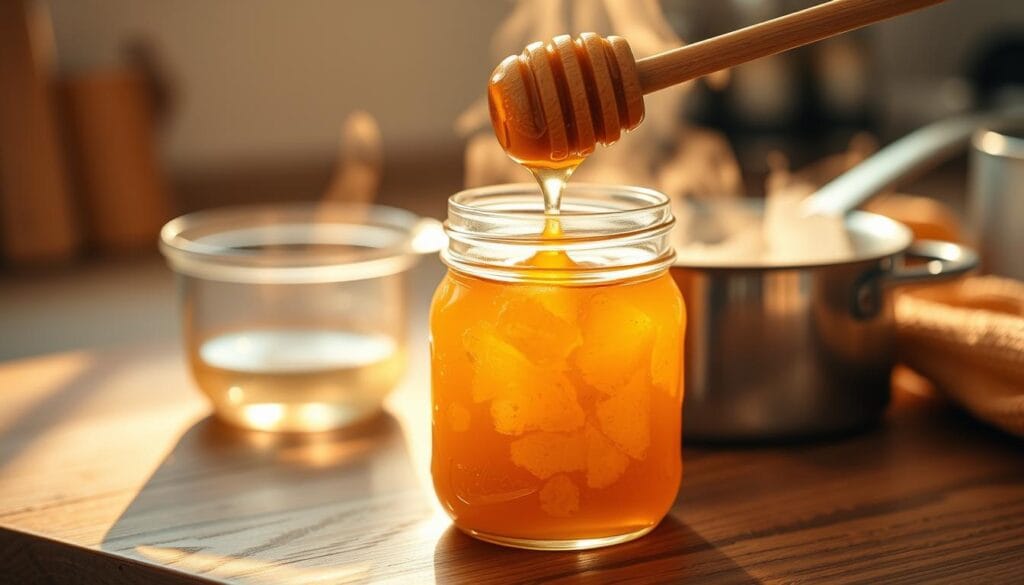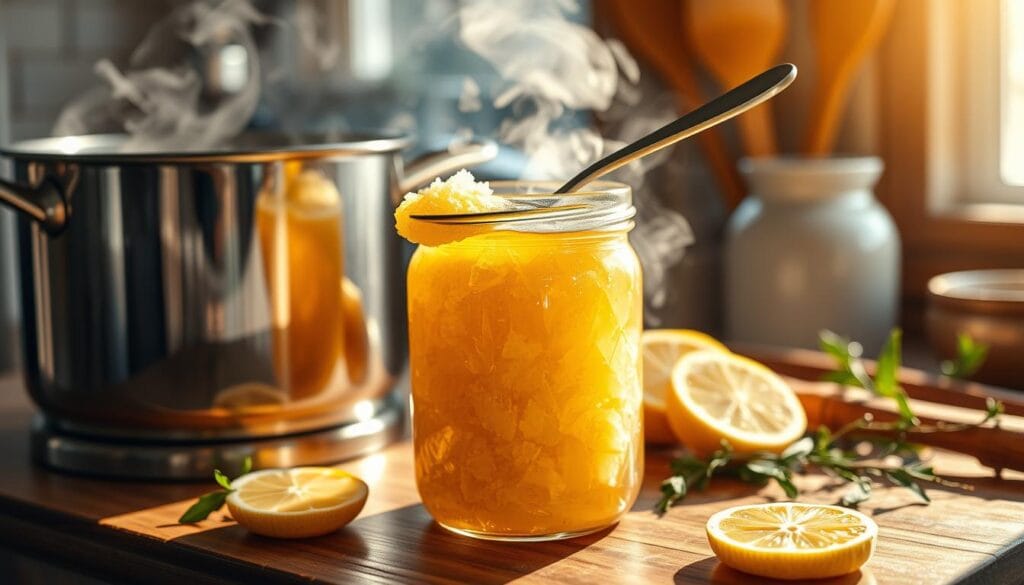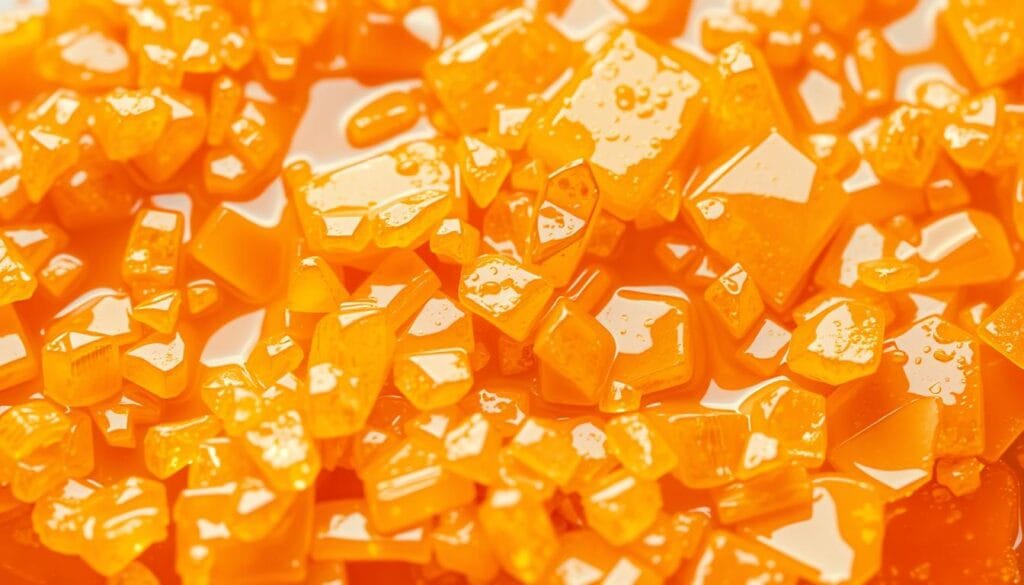I love cooking at home and trying out new recipes. But sometimes, I face a problem – my honey turns solid. Don’t worry, there’s a way to fix it. With a few easy steps, you can make your Crystallized Honey liquid and golden again.
When honey turns solid, it’s not a bad thing. It shows your honey is pure and of high quality. Honey crystallizes naturally because of its unique makeup. This can happen due to the flowers it comes from and the environment.
If your honey has turned solid, or if you want it to stay liquid, I’ve got you covered. The methods I’ll share will make your honey perfect again. Let’s learn how to revive crystallized honey at home.
Understanding Crystallization in Honey
Honey is a natural wonder, loved for its taste, uses, and health perks. But, its tendency to crystallize can confuse many. This happens when its sugars settle and form crystals, a process called granulation or crystallization.
What Causes Honey to Crystalize?
Honey’s high sugar and low water content lead to crystallization. It mainly has glucose and fructose sugars. Over time, the glucose molecules separate from water, turning into crystals.
This change is affected by the honey’s source, water content, storage conditions, and any impurities like pollen or beeswax.
The Science Behind Honey’s Unique Properties
The science behind honey’s crystallization is complex and interesting. The glucose to fructose ratio in honey affects how fast it crystallizes. Honeys with more glucose, like clover and orange blossom, tend to crystallize faster.
On the other hand, honeys with more fructose, such as sage and tupelo, crystallize slower. Knowing this can help you enjoy and care for your honey better.
“Crystallized honey is a sign of a pure, natural product. It’s a testament to honey’s complex chemistry and the hard work of bees.”
| Honey Variety | Crystallization Rate |
|---|---|
| Clover Honey | High |
| Orange Blossom Honey | High |
| Sage Honey | Low |
| Tupelo Honey | Low |
Types of Honey That Crystalize Faster
Honey is a complex and fascinating substance. Each variety shows unique crystallization properties. The rate of crystallization depends on its floral source and composition.
Floral Sources and Their Effects
Honeys high in glucose, like Sunflower Honey and Raspberry Honey, crystalize faster. The glucose-to-fructose ratio is key in determining crystallization.
Raw, unprocessed honey crystalizes faster. It has wax and pollen particles that speed up crystallization. On the other hand, ultra-filtered honey is less likely to crystalize because it lacks these impurities.
Factors That Influence Crystallization
- Water content: Honey with a higher water content, ranging from 13% to 29%, is more susceptible to crystallization.
- Storage temperature: Honey stored at cooler temperatures, around -20°C (-4°F), typically forms finer, smoother crystals, while warmer storage at 20°C (68°F) can result in coarser, less desirable crystallization.
- Impurities: The presence of microscopic particles, such as beeswax and pollen, can act as nucleation sites, accelerating the crystallization process.
Knowing the unique characteristics of different honey types helps you manage and enjoy Melting Crystallized Honey and Reversing Honey Granulation at home.
Safe Methods to Revive Crystallized Honey
If your honey has turned solid, don’t panic. There are safe ways to make it smooth again. We’ll look at the water bath method and other options to fix your honey without losing its good stuff.
The Water Bath Technique
The water bath method is easy and gentle. Put the honey jar in a pot of warm water. Keep the water between 95°F and 110°F. Let it sit for about an hour, stirring now and then, until it’s all liquid again.
Microwaving Honey: Best Practices
Microwaving might seem quick, but it’s not the best choice. It can heat the honey too much, ruining its Honey Texture Restoration and Softening Hardened Honey. If you must microwave, do short bursts of 15-20 seconds, stirring each time.
Alternative Methods to Try
- Dishwasher: Put the sealed honey jar on the top rack of your dishwasher. Run a normal cycle. The warm, moist air can melt the crystals.
- Warm Water Bath: Put the honey jar in a pot of warm water, keeping it between 95°F and 110°F. Stir it now and then as it melts.
- Gentle Heating: Place the honey jar near a radiator, heating system, or a sunny spot in your car. It will slowly melt the crystals.
The trick is to use gentle, steady heat without making the honey too hot. Stirring it helps spread the heat and speeds up the Honey Texture Restoration process.
Precautions When Reviving Honey
Reviving crystallized or candied honey needs care to keep its nutritional value. Avoid overheating, as it can harm the honey. Use low, indirect, and constant heat to melt the crystals gently.
Avoiding Overheating Honey
Heating honey too high can destroy its good stuff. Temperatures over 110°F (43°C) can ruin the pollen, propolis, and antioxidants. Heat above 140°F (60°C) starts to degrade its quality. And, heat over 160°F (71°C) can caramelize the sugars.
To keep Reviving Candied Honey quality high, use gentle heat. Avoid sudden or extreme temperature changes.
Understanding Honey’s Nutritional Properties
Honey is packed with vitamins, minerals, and antioxidants. These nutrients are sensitive to heat and improper handling. By carefully following Honey Decrystallization Methods, you can restore crystallized honey. This way, you preserve its nutritional profile and benefits.
“Maintaining the delicate balance of honey’s natural properties is key when reviving crystallized honey. Gradual, gentle warming is the best approach to avoid compromising its nutritional value.”
The aim of reviving candied honey is to make it liquid again. But, without losing its health benefits. By knowing the right Reviving Candied Honey techniques, you can enjoy its full health benefits.
How to Prevent Honey from Crystallizing
Honey can turn into crystals because of its sugar content. This change is natural but many like it better when it’s liquid. There are ways to stop honey from turning into crystals and keep it smooth.
Proper Storage Techniques
Storing honey right is key to avoiding crystals. Store it in a sealed container, away from sunlight, and at room temperature. Don’t put it in the fridge, as cold can make crystals form faster. Keeping honey at room temperature slows down crystal growth.
Choosing the Right Containers
The container you choose affects honey’s crystal formation. Glass or food-grade plastic containers with tight lids are best. They keep air and moisture out. Don’t use open bowls or loose lids, as they let air in and crystals form.
Some honey makers heat or filter their honey to stop crystals. But these steps might remove good stuff from raw honey.
By following these storage tips, you can keep your honey smooth and liquid. With the right care, you can enjoy honey’s full flavor for a longer time.
Benefits of Crystallized Honey
Many think crystallized honey is bad, but it’s actually good. It makes honey more nutritious and flavorful. This shows how pure and raw honey is.
Nutritional Advantages
The process of Reversing Honey Granulation or Honey Texture Restoration doesn’t hurt honey’s health benefits. Crystallized honey still has all the good stuff like vitamins, minerals, and antioxidants. It keeps its nutritional value because its water content is low, ideally below 20%.
Flavor Profile Changes
When honey crystallizes, it gets creamier and more spreadable. This change also makes its flavor deeper and more complex. Some honeys, like Raspberry Honey, are made to be this way.
Crystallized honey is more than just pretty to look at. By understanding Reversing Honey Granulation, you can enjoy honey in all its forms. This way, you get to fully appreciate its amazing taste.
Popular Uses for Crystallized Honey
Crystallized honey, also known as “hardened” or “candied” honey, is a versatile ingredient. It can be used in many ways in the kitchen. This unique texture adds a delightful twist to traditional honey, offering benefits and uses.
Baking and Cooking Tips – Crystallized Honey
Crystallized honey is great in baked goods. It adds a nice crunch and sweetness. It’s perfect for cookies, scones, and muffins, enhancing their taste and texture.
In savory dishes, it can glaze roasted veggies, add depth to marinades, or top grilled meats. This gives a caramelized finish.
As a Natural Sweetener – Crystallized Honey
Crystallized honey is also a natural sweetener. Enjoy it on toast, over yogurt or oatmeal, or on its own. Its texture and sweetness make it a great choice for those looking for something different.
Whether you’re Softening Hardened Honey or Reviving Candied Honey, it’s versatile. Use it to explore new flavors in your cooking and baking. Discover the unique world of crystallized honey.
When to Discard Crystallized Honey
Crystallization is a natural process in honey over time. It doesn’t mean the honey has spoiled. Honey rarely goes bad and can still be enjoyed even after it crystallizes. But, there are signs to look for when it’s time to throw away your crystallized honey.
Signs of Spoilage – Crystallized Honey
If your crystallized honey smells bad, has changed color, or shows mold, it’s time to get rid of it. These signs mean the honey has spoiled and is not safe to eat. But, crystallization alone doesn’t mean it’s spoiled.
Storage Life of Honey – Crystallized Honey
Honey can last forever if stored right. Keep it in an airtight container, away from moisture, heat, and light. If your crystallized honey doesn’t show any spoilage signs, it’s still good to eat. Many people like the texture and taste of crystallized honey.
Remember, Reviving Crystallized Honey is simple with a warm water bath or microwave. Enjoy your honey at its best by storing it safely and watching for spoilage signs.
Frequently Asked Questions About Honey Crystallization
Honey is a natural sweetener that can turn thick and solid over time. Many wonder if solid honey is safe to eat and if it can be made liquid again. Let’s look at some common questions about honey crystallization.
Is Crystallized Honey Safe to Eat? – Crystallized Honey
Yes, solid honey is safe to eat. The solid form is a natural sign of pure honey. Archaeologists have found ancient honey that’s still good to eat. Honey doesn’t spoil or become harmful over time.
Can You Recrystallize Honey? – Crystallized Honey
Yes, you can make honey liquid again. The process of Reliquefying Solidified Honey and Honey Decrystallization Methods is easy to do at home. Just warm the solid honey gently to enjoy its flavor and benefits.
Moisture, storage temperature, and impurities like pollen can affect how fast honey turns solid. Raw honey crystallizes faster than processed honey. But, you can safely make honey liquid again.
Decrystallizing honey doesn’t change its nutritional value if done right. Honey’s high acidity helps it last long without spoiling. With the right storage, you can enjoy honey for years, even if it turns solid.
Honey Varietals and Their Crystallization Rate
The rate at which honey crystallizes depends on its type. Different flowers and how it’s made can change its makeup. This affects how it turns into crystals.
Differences Between Raw and Processed Honey
Raw honey crystallizes faster than processed honey. Raw honey keeps more pollen and enzymes, helping it turn into crystals quicker. Processed honey, however, is filtered and heated, slowing down this process.
How Local Honey Impacts Crystallization
The place where honey is made can also affect how fast it crystallizes. Honey from certain areas has unique mixes of flowers. For example, Manuka honey from New Zealand can be smooth or thick, depending on its mix.
Knowing about different honey types and how they crystallize is key. By learning to fix granulated honey and melt it, you can enjoy its full taste and texture.
Conclusion: Enjoying Honey at Its Best
Learning about honey crystallization is key to storing and using honey right. Honey stays good, with its health benefits and taste, whether it’s liquid or solid. Knowing how to fix solid honey keeps it quality and healthy.
Appreciating honey’s different textures and looks can deepen your love for it. Honey turns solid naturally, showing it’s real and raw. Knowing how it crystallizes helps you store and fix it, so you always enjoy it.
Exploring and fixing solid honey shows nature’s magic. You can choose to make it smooth or enjoy its texture. Honey always delights and nourishes, giving you a taste of nature’s gift.
FAQ
What causes honey to crystallize?
Honey crystallizes because it has lots of sugar and not much water. The sugar, especially glucose, forms crystals. Things like where the honey comes from, its water content, and how it’s stored can speed up this process.
Is crystallized honey safe to eat?
Yes, crystallized honey is safe and shows it’s pure and raw. You can eat it as it is or warm it up a bit.
Can you recrystallize honey?
Yes, you can recrystallize honey many times without losing much quality. Just make sure to use the right way to warm it up.
What are the best methods to revive crystallized honey?
The best way is to use a water bath. Put the honey jar in warm water (95°F-110°F) for about an hour. Don’t use the microwave, as it can heat unevenly.
How can I prevent honey from crystallizing?
To stop honey from turning solid, keep it in a tight container away from sunlight. Store it at room temperature. Don’t put it in the fridge, as cold temperatures can make it crystallize faster.
Does crystallized honey have the same nutritional value as liquid honey?
Yes, crystallized honey keeps its good stuff. Decrystallizing and recrystallizing it doesn’t change its health benefits if done right.
Which types of honey are more prone to crystallization?
Honey with more glucose crystallizes quicker. Raw honey crystallizes faster than processed honey. Local honey can crystallize differently, depending on its flowers and how it’s made.





